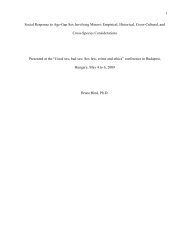Infant and Child Sexuality: A Sociological Perspective - Ipce
Infant and Child Sexuality: A Sociological Perspective - Ipce
Infant and Child Sexuality: A Sociological Perspective - Ipce
Create successful ePaper yourself
Turn your PDF publications into a flip-book with our unique Google optimized e-Paper software.
(Korner, 1973). The male infant has greater muscular strength at birth,<br />
but the female is in no way less active or expressive. On the other<br />
h<strong>and</strong>, the female infant from birth shows more oral sensitivity, engages<br />
in more frequent mouth dominated approaches, <strong>and</strong> is a more frequent<br />
<strong>and</strong> more persistent thumb sucker. Newborn females also exhibit<br />
greater cutaneous sensitivity than do males.<br />
Parents also treat male <strong>and</strong> female infants differently right from<br />
the start, hence there is constant parental reinforcement not only of<br />
innate differences but also of differences in what society regards as<br />
gender-appropriate behavior. In other words, the infant’s unique male<br />
or female characteristics, as well as cultural expectations, may affect<br />
the nature of parent-infant interaction from the day of birth <strong>and</strong><br />
onward. Moss (Segal, 1971) found, for instance, that mothers had significantly<br />
more contact with infant boys than girls on such variables<br />
as “attends” <strong>and</strong> “stimulates-arouses.”<br />
<strong>Infant</strong>s can also be divided into two categories based on the extent<br />
to which they seek close personal contacts--non-cuddlers <strong>and</strong> cuddlers.<br />
(Schaffer <strong>and</strong> Emerson, 1964b). Non-cuddlers reach this<br />
developmental stage somewhat later than do cuddlers.<br />
Non-cuddlers show displeasure at being restricted <strong>and</strong> contained<br />
from the early weeks--initially through restlessness. At nine or ten<br />
months, when they can crawl or walk away, resistance to h<strong>and</strong>ling becomes<br />
still more pronounced. This does not mean the non-cuddlers show a<br />
lack of orientation toward the mother; she is still treated as a “haven<br />
of safety” <strong>and</strong> when frightened, the non-cuddler seeks her proximity.<br />
Their means of establishing proximity is, however, different from<br />
that of cuddlers. Instead of the close physical contact which other infants<br />
seek, the non-cuddler either makes visual contact with his<br />
mother, establishes a physical contact such as holding onto her skirt,<br />
or hides his face against her knee. Apparently it is not contact per se<br />
that is avoided by non-cuddlers but the restriction of movement that is<br />
involved in cuddling <strong>and</strong> holding encounters. In motor development the<br />
non-cuddlers are ahead of the cuddlers, reaching such milestones as the<br />
ability to sit unsupported, to st<strong>and</strong> holding on, <strong>and</strong> to crawl considerably<br />
sooner than the cuddlers.<br />
Resistance to close physical contact does not appear to be primarily<br />
a social phenomenon but an expression of an innate, more general<br />
aspect of the infant’s personality. Nor is the non-cuddling pattern a<br />
bad sign prognostically; it is not a determent to development as persons.<br />
It appears, therefore, that for some infants intimate contact is<br />
not acceptable. Certain forms of it may be appreciated, such as rough<br />
play <strong>and</strong> being carried. But the closer more intimate kind of physical<br />
contact which appears to be so satisfying to some infants is resisted<br />
<strong>and</strong> actively avoided. As a result, the total amount of h<strong>and</strong>ling received<br />
by non-cuddlers is likely to be considerably less than that received<br />
by cuddly infants. The nature of the non-cuddler’s interaction<br />
with others assumes a less direct <strong>and</strong> tactile form.<br />
In sum, infants approach encounters in an active-selective rather<br />
than a r<strong>and</strong>om-passive manner. They form attachments for others on the<br />
basis of the kinds of stimulation they want <strong>and</strong> get. Non-cuddlers compel<br />
their parents to find a kind of interaction with them that is<br />
10
















